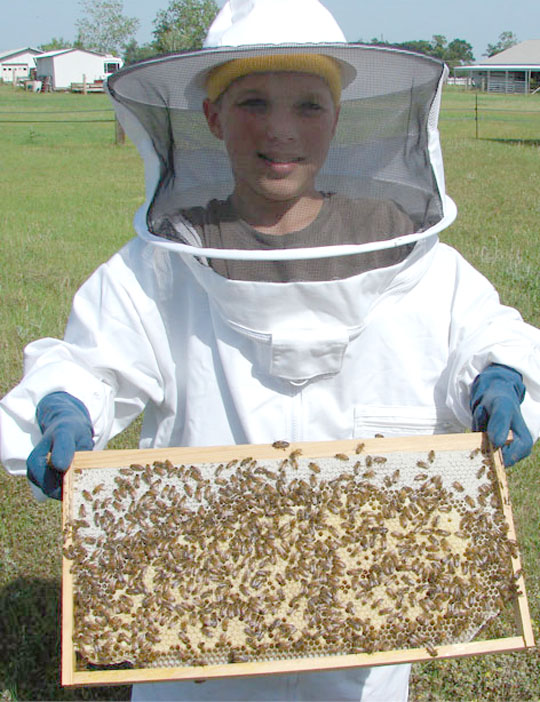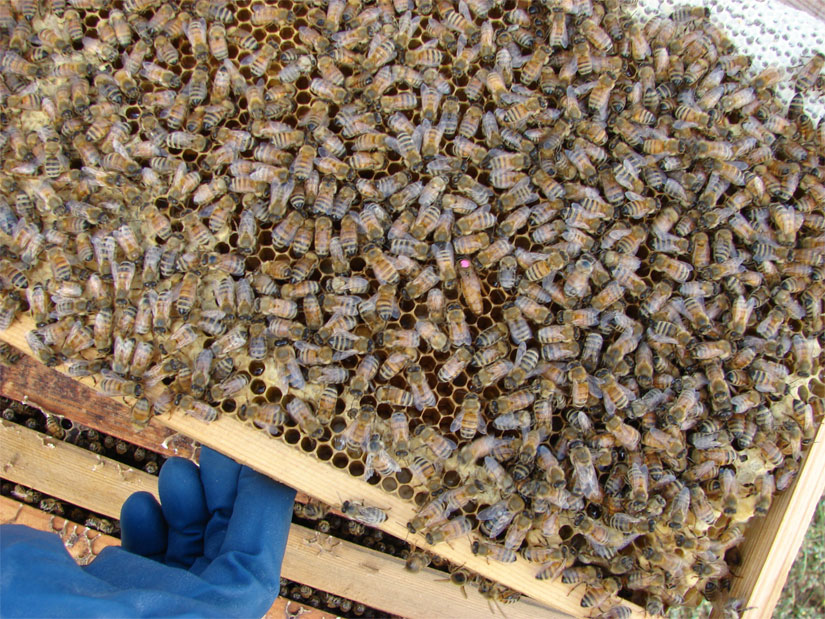North Escambia Bee Association Holds Chautauqua
March 1, 2009
The Third Annual North Escambia Bee Association Chautauqua (workshop) was held last Saturday at Northview High School.
Joan Strickland filed the following report for NorthEscambia.com –
For a photo gallery from the Chautauqua, click here.
There was a good attendance at the 3rd Annual NEBA Chautauqua and we had informative speakers. David Westervelt shared some new techniques in testing bees, one was an IVDS –Integrated Virus Detection System (learn more at www.bvs-inc.us/). His Powerpoint presentation included a detailed cross section of a honeybee that came from www.beemaster.com (there is a lot of information on their site). I was not able to locate the cross section on John Clayton’s site but am sending him an e-mail to request that he share the pic or at least a link with us. The notation under the pic was www.beemaster.com/honeybee/beexray.gif David talked also about the wax in the hive and how many molecules can be stored in that wax, found through lab testing they have been doing. Bees generally forage up to 5-7 miles from the hive and can encounter many hazards along the way. It made us more aware of chemicals and pesticides that we or others may be using that could affect our hives. We learned about non-toxic control of varroa mites using powdered sugar. The powdered sugar coats the bees and then as they groom and clean each other off the varroa are removed as well.
We learned about Small Hive Beetles and new traps being tested to help control their population. They can overtake a hive of bees in a short period of time. Several traps commonly in use are the AJ Beetle trap and the West SHB trap, using no toxic chemicals. Fill the AJ trap with vegetable oil and place it between the top bars in the hive. Sprinkle the pan on the West SHB trap with pickling lime, cover it with the special slotted lid and place it on your bottom board, you could use vegetable oil in place of the lime.
Elmore Herman spoke to us about marketing hive products and some of the challenges we may face here in Florida with regulations. He encouraged us to be in contact with Florida Farm Bureau and our local and state representatives to learn more about how we can help change the regulations (Department of Agriculture – food safety division) on bottling honey for the small / hobby beekeepers. In addition it was good to know what the larger bottlers are having to endure. One man from Okaloosa County shared with us his experience with state regulations, that was Mark Bundrick. Perhaps he will reply in a blog tied to this story and share his experience. Elmore shared information with us about how beneficial the bees are to crops being grown. One could expect to get $55 per hive on a watermelon field. One hive could cover 1-2 acres. We learned too how both the bee keeper and the squash grower could work hand in hand (or hive in field) to benefit one another.
Dan Mullins, Santa Rosa County Extension Horticulture Agent gave a presentation on both beneficial and harmful plants common to our area. During the break I met his wife, Vickie, who is the Santa Rosa 4H Coordinator. Vickie was right there, hands on and offered great information to those interested in a beekeeping 4H club.
We enjoyed a great BBQ lunch (part of the package for the day) prepared by Archie Weaver. Rossman Apiaries was there with their bee keeping products and set up along the hallway. Many placed their orders a week or more in advance and Rossman brought their orders to the event to save their customer money on shipping, much appreciated in these economically challenging times. Rossman brought a large selection of item for us to be able to shop throughout the day. Fred Rossman and his son-in-law Clint Gay were there, Clint taking care of the sales and Fred on hand to answer most any question we had. Both were so pleasant, knowledgeable and informative.
After lunch we split into groups and had a choice of advanced beekeeping curriculum and beginner beekeeping curriculum. I, of course, was in the beginning group having managed my bees for going on two years. For the beginning group there were these topics: Assembling Wooden Ware; Bee Pests; Splitting; Bee Diseases. For the advanced group the topics were: Raising Queens; a Forum with Laurence Cutts; Marketing; How to Render Propolis and Wax. See the attached itinerary for a list of who taught what in the afternoon. I learned some new and valuable information from David Westervelt in the Splitting class. He showed us about making a mark across several cells on a frame that we wanted to raise a new queen from, this could potentially raise more than one queen.
There were a gracious plenty of door prizes given, won by the drawing of tickets throughout the day. Some won hive tools, some a new style bottle (available through GloryBee Foods), some caps and a five frame nuc. Two of the winners are pictured, they were Andrew Waltrip and Dale Campbell Jr.
Toward the end of our lunch break I came back into the main meeting room (one of the school shop classrooms) and caught the tail end of information that David Westervelt was sharing about a trip he took to Haiti to help folks there learn more about beekeeping. We take for granted the supplies we have readily on hand! A small amount of powdered sugar costs them $3 which is about a weeks’ worth of wage to them. Both David and Doug Corbin have been on these teaching trips there. I am hoping they will reply to the blog on this story and perhaps even share their pics and a story of their own to follow this one.
 Throughout the day I met several folks there and had an opportunity to learn more about them. During one of the periods between teaching it was asked who was the oldest beekeeper there, that would be Rex Aldridge at 88, the youngest was Rosalyn Miller, I believe she is seven years old and helps her Dad Tony Miller in their hive keeping. Aden Davis (pictured left), 11 years old, was the youngest to have registered and managed his own hives. Aden started about a year ago. His mentor is Laney Hiller. Aden bought his first two queens from Lawrence Cutts over in Chipley, FL. Aden participates in the Bee Bunch group which is a Christian group of bee keeping acquaintances. Nine of the Bee Bunch were in attendance at the Chautauqua. Laney is our coordinator for the Bee Bunch. Aden, with some assistance from Laney, has presented his bees at his school for career day. He is rather knowledgeable for his age and applies himself at learning all he can to keep his bees and share information with others.
Throughout the day I met several folks there and had an opportunity to learn more about them. During one of the periods between teaching it was asked who was the oldest beekeeper there, that would be Rex Aldridge at 88, the youngest was Rosalyn Miller, I believe she is seven years old and helps her Dad Tony Miller in their hive keeping. Aden Davis (pictured left), 11 years old, was the youngest to have registered and managed his own hives. Aden started about a year ago. His mentor is Laney Hiller. Aden bought his first two queens from Lawrence Cutts over in Chipley, FL. Aden participates in the Bee Bunch group which is a Christian group of bee keeping acquaintances. Nine of the Bee Bunch were in attendance at the Chautauqua. Laney is our coordinator for the Bee Bunch. Aden, with some assistance from Laney, has presented his bees at his school for career day. He is rather knowledgeable for his age and applies himself at learning all he can to keep his bees and share information with others.
Rex Aldridge has been keeping bees since he was eight years old. He is a member of the Robertsdale Beekeeping Association. He shared with me that he was in the Army for 38 months, participated at Omaha Beach and was awarded five bronze stars. He got his first box of bees at eight years old by swapping a box of sweet potatoes for a box of bees, this was in Chilton County, Ala. Rex stated that he was one of the first folks to experiment with and start growing peaches in Chilton County.
OJ Blount from Andalusia, Ala., was there and had an interesting display to share with us that he calls The Queens Castle. OJ has been keeping bees for about 30 years and enjoys helping other beekeeping hobbyists. He uses a completely natural beekeeping method with no chemicals of any kind. OJ is 82 years old and says he is still learning about the health of bees as well as his own health. He tries to eat right and help his bees stay healthy by keeping their hives clean (that alone would account for an exercise program). OJ was a cook in the military and enjoys cooking still and brought some brownies that he shared. They were made with muscadines and honey and were very light and wonderful. A diabetic could have appreciated them as well as the rest of us did!
For a photo gallery from the Chautauqua, click here.
Pictured top: A hive of bees. Pictured inset: Beekeeper Aden Davis, 11, with a hive. Submitted photos by Joan Strickland for NorthEscambia.com, click to enlarge.
Comments
One Response to “North Escambia Bee Association Holds Chautauqua”




Thank you for this very well written report on the Chautauqua. It took the planning of seven people and the execution of about 30 more volunteers. We really appreciate your involvement with covering this very successful meeting with photos and a written essay.
Ernest (Peaches) Peach
Chautauqua Chairman